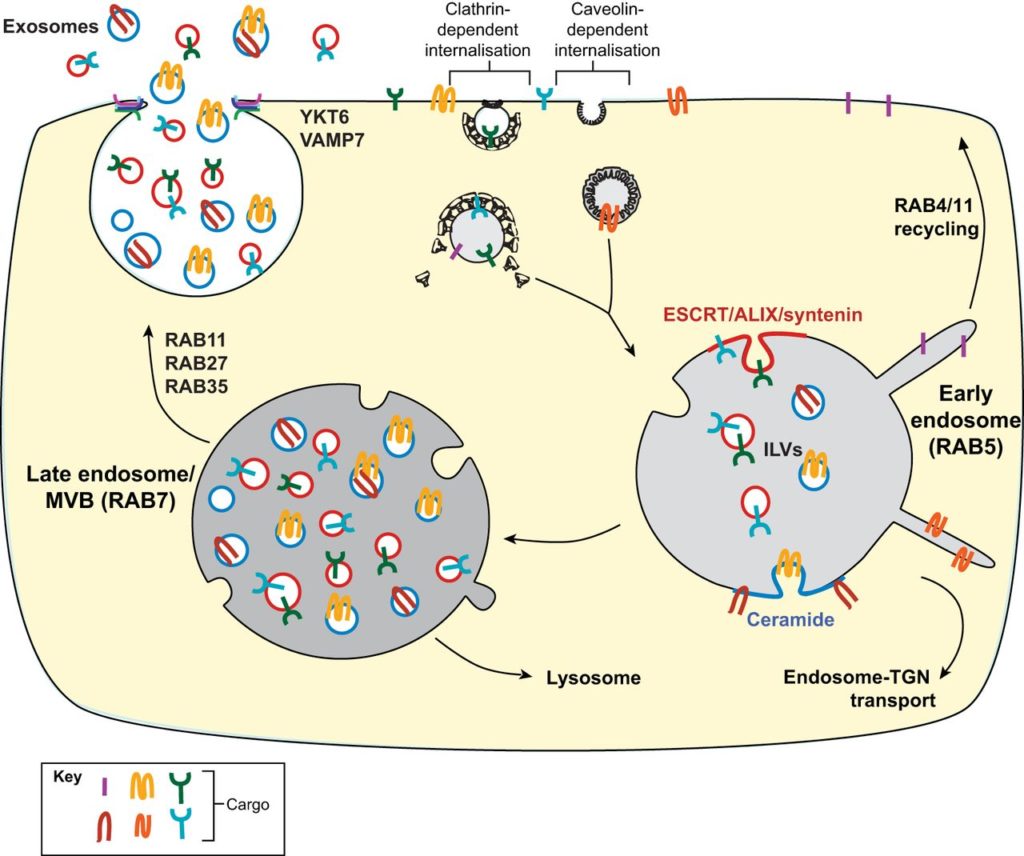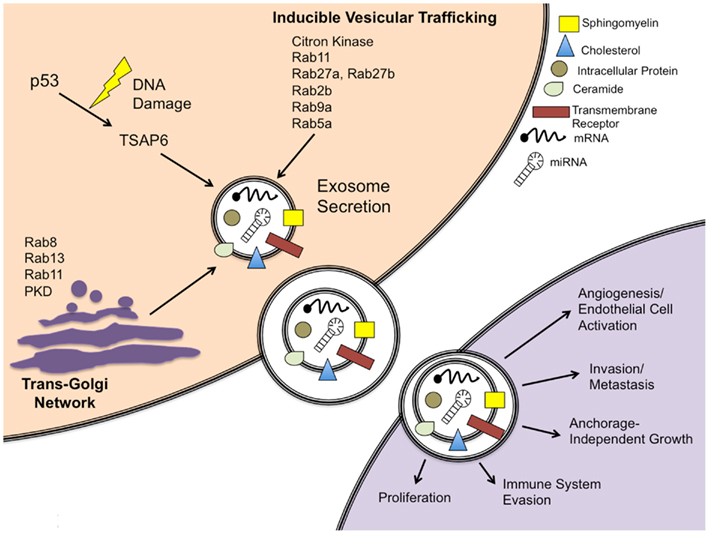Uncategorized Friday, 2019/05/10
In the early 1980s, researchers discovered exocytosis in normal cells or tumor cells cultured in vitro, and cells secreted vesicle structures with cell membrane characteristics in their culture medium. In 1983, Johnstone found that in vitro cultured sheep stromal erythrocytes excreted small vesicle structures containing transferrin receptors during maturation, they named the small vesicle structure released by the cell as an exosomes.
Early detection of exocrine-secreting cells is mainly hematopoietic cell lines such as B cells, T cells, dendritic cells, mast cells, and platelets. As research progresses, many non-hematopoietic cells also produce exosomes, such as tumor cells, epidermal cells and nerve cells.
The exosomes secreted by the donor cells can be directly absorbed by the surrounding recipient cells in the same tissue, meanwhile, the exosomes can also enter the body fluid circulation, such as blood, saliva, urine, cerebrospinal fluid, etc. Through body fluid transport, it is absorbed by recipient cells in different tissues to achieve inter-organizational material exchange.

The formation and function of exosome Exosomes cannot be simply understood as vesicle structures secreted directly by the cells to the external environment, and their formation process has complex regulation, which can be divided into three stages: cell membrane invagination forms intracellular bodies, intracellular body polyvesicularization, multivesicular body and plasma membrane fusion to release exosomes.
Eukaryotic endocytosis forms the early endosome, late endosome is matured under the regulation of the Golgi apparatus and proteins such as the endosome protein sorting and transport device (ESCRT). The outer membrane of the late endosome often invades to form many small vesicle structures, so that the late endosome often contains many vesicles, so it is also called multivesicular bodies (MVB). Some of these MVBs are directly fused to the lysomsome and degraded; some MVBs are transported to the Golgi for recovery; while some MVBs are fused with the plasma membrane to release small vesicles to extracellular, which are called exosomes. The secretion of exosomes by cells is precisely regulated by cells, including a series of regulation proteins (ESCRT, Rab, etc.), the effects of intracellular (calcium ion concentration, amino acid concentration, etc.) and extracellular (pH, etc.) environments.
Exosomes are biologically active vesicular structures containing liposomes, proteins, RNA and miRNAs. It can not only be absorbed by surrounding cells, but also can be absorbed by different tissue cells in the body fluid circulation, realize the transfer of substances and information between cells, participate in the regulation of gene expression levels of recipient cells, and ultimately affect the physiological functions of recipient cells.
Exosomes are involved in many biological functions, including immune regulation, and B lymphocytes release exosomes carrying antigen-presenting proteins to induce T lymphocyte immune responses; leading to the formation and development of some diseases, such as Alzheimer's disease; promoting viral infection and transmission, such as HIV virus can find the most suitable cells for infection and transmission through exosomes; in addition, exosomes play an important role in cancer.
Role in the occurrence and deterioration of cancer In 1981, it was found that cancer cells cultured in vitro had exocrine phenomenon, then the exosomes were found released in many cancer cells, such as ovarian cancer, breast cancer, prostate cancer, and colorectal cancer. More than this, cancer cells often release exosomes higher than normal cells, for example, the content of EpCAM-positive exosomes in the blood of patients with ovarian cancer is significantly higher than that of normal people and patients with benign ovarian diseases. The secretion of a large number of exosomes by cancer cells may be due to the mutation of certain protooncogenes or tumor suppressor genes, which may increase the formation or secretion of exosomes; at the same time, the low pH microenvironment around the cancer cells may induce a large amount of secretion of exosomes.
Exosomes secreted by cancer cells play an important role in the occurrence and deterioration of cancer. Exosomes can promote the proliferation, spread and help cancer cells escape the clearance mechanisms from the body itself or in vitro.
. Exosomes promote the proliferation of cancer cells By secreting exosomes, cancer cells transport the carcinogenic factors (proteins, nucleic acids, etc.) in the cells to the recipient cells, which promotes proliferation and canceration of the recipient cells. Exosome secreted by breast cancer containing HER2 proto-oncoprotein, exosome secreted by ovarian cancer contains miR-21, which can activate the proto-oncogene of the recipient cell, inhibit its tumor suppressor gene, and promote the proliferation of cancer cells.
Cancer cells can release exosomes with apoptotic factors (caspase-3, etc.) to reduce their apoptotic activity; at the same time, exosomes containing apoptosis-inhibiting factors (survivin, etc.) are released outward, enter the recipient cells, reduce the apoptotic activity of the receptor cells, and promote the proliferation of cancer cells.
By secreting exosomes carrying angiogenic factors (Del-1, miR-210, etc.), cancer cells are absorbed by endothelial cells in the vicinity of cancerous tissues, promoting the formation of new blood vessels in cancerous tissues, and providing more nutrients for tumor growth.
 . Help cancer cells escape the immune system or remove drugs
Exocrine secreted by cancer cells can inhibit the immune response to cancer cells, and can inhibit the T cell immune response by activating bone marrow-derived inhibitory cells (MDSC), or reduce the immune response of cells by destroying the tumor antigen presenting process. Meanwhile, exosomes can also induce apoptosis of immune cells, such as Fas ligand in prostate cancer exosomes to induce apoptosis of T lymphocytes. Therefore, exosomes can reduce the activity of the immune system and help cancer cells escape immune clearance.
. Help cancer cells escape the immune system or remove drugs
Exocrine secreted by cancer cells can inhibit the immune response to cancer cells, and can inhibit the T cell immune response by activating bone marrow-derived inhibitory cells (MDSC), or reduce the immune response of cells by destroying the tumor antigen presenting process. Meanwhile, exosomes can also induce apoptosis of immune cells, such as Fas ligand in prostate cancer exosomes to induce apoptosis of T lymphocytes. Therefore, exosomes can reduce the activity of the immune system and help cancer cells escape immune clearance.
In addition, studies have found that in the treatment of cancer, cancer cells can secrete exosomes to transport drugs from the cells to the outside of the cells to reduce the toxicity of drugs to cells (melanoma cisplatin treatment process). At the same time, it has also been found that cancer cells that are resistant to drugs can secrete exosomes carrying drug-resistant factors, and can be produced by other cancer cells to produce drug resistance. Therefore, exosomes can help cancer cells escape the elimination of drugs. . Create a favorable microenvironment for the spread of cancer cells The exosomes secreted by cancer cells not only create a suitable microenvironment for the growth of cancer inside the tissue, but also enter the different tissues through body fluids, establish a microenvironment that is conducive to the growth of cancer cells, and form favorable conditions for the spread of cancer cells. The most common is that when cancer cells spread to the lymph nodes, a large number of exosomes are secreted into the lymph nodes, creating a suitable microenvironment for cancer cells to grow in the lymph nodes.
Exosomes, like a "sword" of cancer, can promote the proliferation of cancer cells and help cancer cells escape immunity or drug clearance, creating a suitable microenvironment for the spread of cancer and playing an important role in the occurrence and deterioration of cancer. However, this is a "double-edged sword" that exposes the presence of cancer and is an effective means of cancer diagnosis while facilitating cancer. The close relationship between exosomes and cancer also provides a new strategy for the effective treatment.
